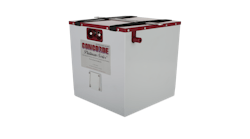Online Exclusive: The Importance of Battery Testing
Just like any other device, batteries need to be tested to determine if they are airworthy. That is, to determine if they will perform properly when required under normal conditions and more so when needed in emergency situations.
While on the ground, if the battery is not capable of performing it could simply result in an annoying and expensive AOG situation but, if there is a problem in flight and the batteries do not perform, this can now become a serious emergency. Will the batteries provide the power needed to start the APU? Will the batteries be able to power all required avionics and allow for a safe touchdown? (n 2008 a Qantas 747 lost electrical power while on approach to Bangkok and the pilot had to rely exclusively on battery power. This is as real as it gets.)
The problem with battery testing is that a simple voltmeter measurement will not provide information on how the battery will perform. Yes, the voltmeter reading can give some idea on the state of charge (more so on lead-acid batteries than on nickel-cadmium) but the voltmeter reading cannot be used to determine if the battery will deliver the rated current for the specified duration.
Therefore, bench testing is needed to determine capacity and charge acceptance as specified by the manufacturers of the batteries.
Capacity is the most basic and most important of the tests. A “Capacity Test” is performed by discharging the battery and verifying that the battery voltage will remain above a minimum voltage in the specified period of time.
Charge acceptance testing is also important. It is not enough to simply pump current into the battery. Each of the cells and the total battery must exhibit a proper response to the current. This means that the voltage must rise properly, that voltages do not fall, and that there is no increase in temperature.
The procedure for battery testing is straightforward but it is by no means simple. It is possible, however, to simplify the process by having a disciplined methodology, equipment that will allow an accurate and simplified performance and a systematic method to determine pass-fail conditions.
Capacity tests
Capacity is the most basic and most important test. It goes along with the rating of the battery. A 40A nickel-cadmium battery is expected to deliver 40A, for one hour, with the voltage of each cell remaining above 1V.
This test is performed by applying a constant current load equal to the battery A-Hr rating, while monitoring the voltage of the battery and volage of each of the cells. (Constant current discharge is the basic test form. In some cases a resistive load may be specified by the manufacturer but this is seen more in small battery packs (emergency power supplies).) The battery will pass the capacity test if at the end of one hour the battery voltage is above the minimum (20 volts for a 20 cell battery) and if each of the cells is above 1 volt. (One hour is the typical time limit. Each battery manufacturer and/or appliance manufacturer may specify other time limits, usually shorter.)
The difficulty here is the monitoring of the cells. There are 20 cells in a typical battery and each one needs to be measured before, during and at the end of the test. If this is done manually (measure and write) there are many opportunities to take a wrong reading, skip a cell, etc.
In addition, measuring 20 cells manually means that there will be a considerable time difference between the reading of the first cell and the reading of the last cell. This is aggravated by the fact that the voltage of nickel-cadmium cells fall rather rapidly at the end of their useful capacity. In a battery with marginal capacity, the first cells would pass but the last ones would not. And even on a “good” battery the difference in the readings will result in an inaccurate picture of the condition of the battery.
Charge tests
Charge acceptance is the other side of battery testing. It is not sufficient that a battery passes capacity; it must also demonstrate that all cells can properly transform the charge current into charge stored in the plates.
This test is performed by applying a constant current charge for a time period. (There are other charge methods besides constant current, such as constant voltage and pulse, but constant current is the method specified by battery manufacturers for proper determination of the condition of the cells.) A 40A nickel-cadmium battery is typically charged at 20A for two hours (100 percent main charge) and at 4A for four additional hours (40 percent overcharge) while monitoring the voltage of each of the cells. (The overcharge is required because the charge process is not 100 percent efficient and gets less and less efficient as the cell is charged.)
Nickel-cadmium (vented) cells have a minimum charge voltage requirement of 1.50V with 1.55V to 1.65V being the typical voltages developed by cells that have been deep cycled several times. In addition, cell voltages must never drop and there must not be an appreciable increase on temperature. A drop in cell voltage (50mV) and/or a significant warming (5 C) could indicate a cell separator failure. (In the event of a cell separator failure, the cell must be replaced because cells cannot be repaired.)
Automation of cell voltage measurements
Since a cell failure can occur at any time during the charge/discharge test, it is important to be able to monitor the performance of the cells on a continuous basis, but this is not practical unless it is automated.
Automation simplifies the measurement task but more importantly it makes it accurate and timely. And, since measurement automation implies data recording, the test data is automatically archived for retrieval at any time.
Furthermore, once there is cell voltage measurement automation it follows that there can be battery voltage, battery temperature and charge/discharge current measurement as well.
Evaluation
Once battery test data is collected, the next step is to analyze it to determine the condition of each cell individually and of the entire battery. Typical questions are centered on: Initial condition of the battery/cells; as received voltages; first capacity test; first charge and water level. How did the battery/cells do in subsequent tests? Did capacity time improve? Did failing cells recovered? Was the charge voltage acceptable? Did the battery remain cool during charge? Did any of the cells require more than expected water for electrolyte leveling?
Summary
With an automated system than produces color coded bar graphs it becomes a lot simpler to observe and determine the condition of the battery. This makes a final pass/fail determination a lot more assertive and it also allows for spotting early failures that can shorten the test time.
With all the data archived for retrieval at any time, it is then possible to easily compare new results with prior ones, thus providing a clear picture of the condition of the battery as it ages.
At this time, when more is required from fewer resources, automation of the battery test process results in accuracy and efficiency in the operation of a battery test facility.
Joseph F. Mibelli, a graduate of the University of Miami with a BSEE degree, established JFM Engineering in 1978 to develop and manufacture precision equipment for aircraft battery testing. More information is available at www.jfmeng.com.





